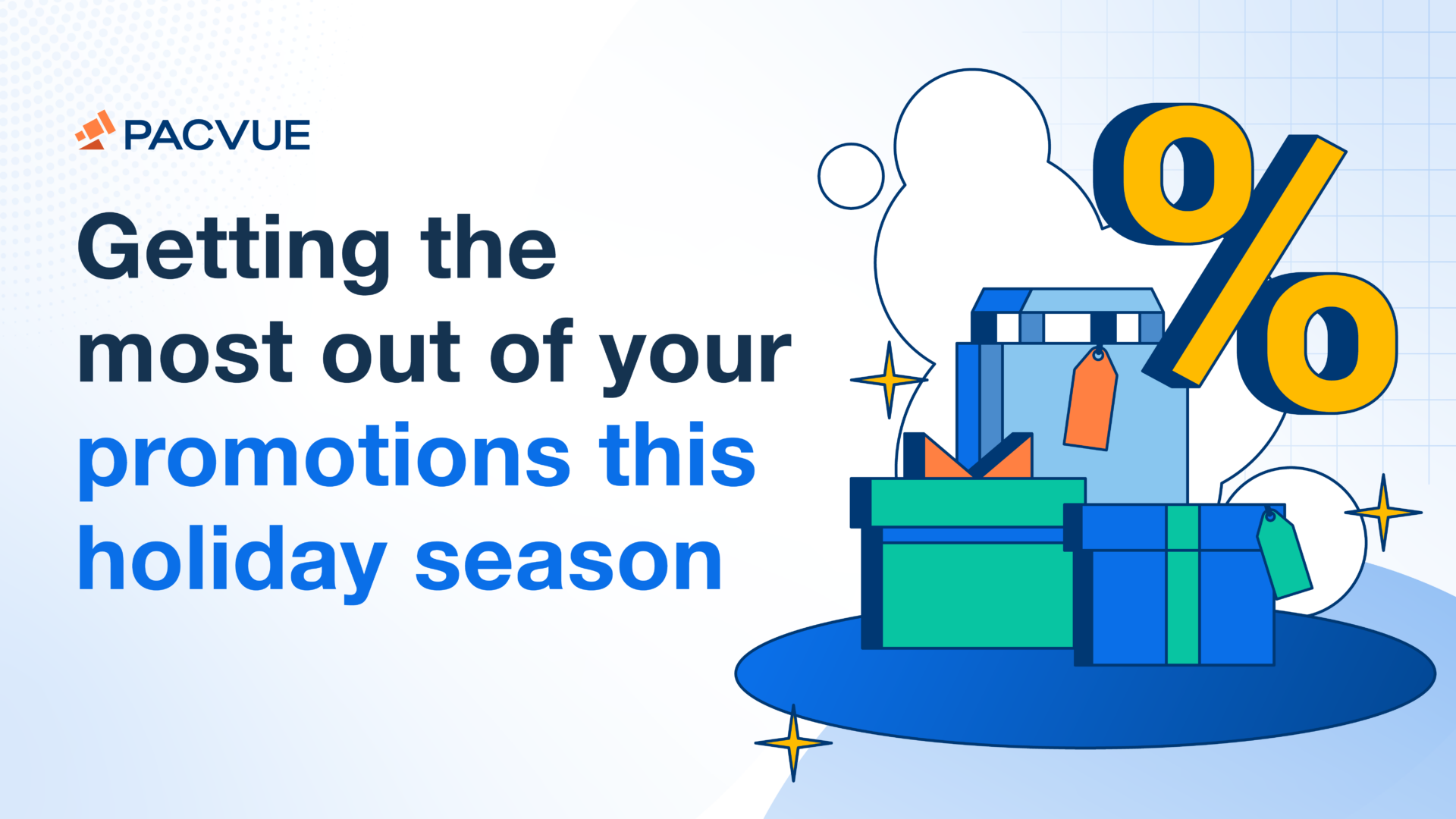Holiday season promotions are set to be more complex in 2024. This November, a high-stakes presidential election is expected to dominate the media and potentially distract consumer attention from the shopping frenzy. Compounding this, Thanksgiving falls later than usual, compressing the holiday shopping period and reducing the time between Black Friday, Cyber Monday, and Christmas. This shortened timeframe means consumers are likely to be more decisive and focused on their holiday spending. It also means that sellers need to be shrewd about their retail media promotional strategy.
Promotions can work alongside sponsored ads and search placements to ensure your brand is top-of-mind when consumers are ready to purchase. In this guide, we’ll show you how to use commerce media tools to manage and optimize your holiday season promotions across retailers like Amazon, Walmart, and Instacart.
Here’s what we’ll cover:
- Running promotions on Amazon, Walmart, and Instacart, with specific Black Friday and Cyber Monday strategies—tentpole events when consumers are actively seeking deals.
- How to maximize profitability during Black Friday and other key holiday shopping events, even when retail media and promotional costs are higher.
- Measuring the success of your promotions with key indicators like share of voice (SOV) and incremental return on ad spend (iROAS).
What is the 2024 holiday outlook for retail media? Use promotions to seize the opportunities.
Although the holiday shopping period may be slightly shorter this year, there’s no doubt that the holidays remain a massive opportunity for brands to capitalize on increased consumer spending.
eMarketer estimates that 50% of holiday shoppers will be doing their shopping between Thanksgiving and the last two weeks of December, and Adobe projects that holiday-related eCommerce spending will accelerate this 2024 after two slower years slumped by inflationary woes.
Brands that effectively employ sound digital shelf optimization and retail media promotional strategies will achieve the coveted trifecta of eCommerce excellence:
- Traffic: While customers are actively searching for deals, you’ll be ready with enticing promotions and ads that capture this surge in traffic.
- Sales: Your stellar digital shelf presence – product content, pricing, availability, and reviews – will convert that traffic into sales.
- Halo Effect: The sales boost from your promotions, and ads will create a “halo effect,” increasing brand recognition, organic ranking, and long-term sales.
Promotion types on Amazon, Walmart, and Instacart
Each platform has its nuances when it comes to promotions, but they all share one common thread: getting the timing, inventory, and ad spend right can lead to huge rewards with Black Friday, Cyber Monday, and the lead-in and lead-out to Cyber 5 promotions.
The key to success during these peak shopping periods isn’t just offering discounts—it’s about ensuring you have the right products available and that your promotions are set up to run seamlessly.
Running promotions on Amazon: Use Lightning Deals and Deal of the Day promos to fuel the halo effect
Amazon supports four main types of seller discounts: deals, promotions, coupons, and Prime-exclusive discounts.
- Amazon Deals capitalize on shopper FOMO with limited-time discounts. These are especially effective during high-traffic events like Black Friday and Cyber Monday when traffic and purchase intent is at its peak. Two of the most effective are Lightening Deals, lasting 4-12 hours, and Deal of the Day, lasting 24-hours. Both create urgency with time-sensitive discounts, but are also more costly to run, making profitability crucial when managing retail media promotions during the holiday period (more on profitability below).
- Coupons are a cost-effective way of increasing click-through-rates due to their visibility on search and ad pages. They can be used across all products and are highlighted on brand pages, product detail pages, and inside customer carts.
- Prime-exclusive discounts are targeted at Prime members, appearing in search results and during tentpole events like Black Friday. These discounts show a reduced price with the original price crossed out, enhancing conversion rates and boosting click-through rates for brands.
Running promotions on Walmart: Maximize visibility and conversion rates with Discounts, Coupons, and Sponsored Products Ads
Walmart often organizes holiday sales into multiple events, using promotions like rollbacks and early access for Walmart+ members. While Walmart controls the rollback process, you can coordinate with their merchandising team to participate in these promotions.
Here’s a breakdown of Walmart promotions over which you have total control:
- Reduced Price: Temporary discounts that are clearly marked with a “Reduced” badge on the product listing. These discounts gain prominence in search results, making them ideal for high-traffic events like Black Friday.
- Clearance: Items marked as “Clearance” come with a comparison price and are often used to clear out inventory at a deep discount.
- In Cart/In Checkout: Discounts are applied only during the checkout process, creating a sense of exclusivity and encouraging conversion.
Combining these Walmart promotions with Walmart Connect Ads allows you to expand your reach through targeted sponsored campaigns. Pacvue’s tools include budget management to automate bidding and optimize ad spend, helping you handle higher CPC rates during peak periods like Black Friday and Cyber Monday.
Running promotions on Instacart: Capture grocery shoppers with targeted promotions for high-impact holiday sales
Instacart promotions are particularly effective for grocery and CPG brands aiming to engage a highly attentive customer base. Instacart offers three main promotion types:
- Spend $X, Save $Y: Encourages larger basket sizes by offering savings when a customer spends a certain amount.
- Save $Y: Offers a direct discount on a single item to promote product trials and conversions.
- Buy X, Save $Y: A multi-unit promotion aimed at increasing basket size with deals like “Buy 2, Save $5.”
Pacvue supports Instacart promotions and ad management within a single platform so that you can strategically balance visibility and discount-driven sales without overshooting your budget. We uniquely support the creation and management of all three types of Instacart promotions directly through our omnichannel commerce platform. This flexibility allows sellers to test different promotions while setting campaign caps to control costs and report on which types are most effective during the holidays.
How do I ensure I remain profitable when using promotions?
What threatens seller profitability during the holidays? Running promotions on platforms like Amazon, Walmart, and Instacart can impact margins for several reasons:
- Discount Pressure: Promotions, like coupons or price cuts, reduce the selling price of your products, cutting into margins.
- Increased Competition: The holiday season brings intense competition, raising the cost of retail media ads (like sponsored products or search ads) as more brands bid for visibility, inflating cost-per-click (CPC) rates.
- Inventory Management: Higher demand can lead to out-of-stock situations or excess inventory if poorly managed, affecting potential sales and profitability.
Balancing promotional spend with profit margins is crucial during the holiday season, especially when managing promotions across multiple retailers. The challenge lies in tracking and measuring all the moving parts—sales, discounts, ad costs, and inventory—while staying profitable. A commerce media platform like Pacvue simplifies this process by helping you develop a cross-retailer strategy that ensures your promotions and ads are as effective as possible.
Pacvue provides tools to measure sales, promotions, and advertising performance in one place, along with forecasting features that align promotional plans with inventory levels. This ensures you avoid aggressive promotions that might lead to out-of-stock situations, protecting your brand’s reputation and sales. You can track key metrics such as CPC, conversion rates, and promotional costs to stay within budget and hit your targets. For example, Pacvue’s commerce rules can automate spending and inventory adjustments for Amazon or Instacart promotions, ensuring profitability during high-demand periods like the holiday season.
How can I measure the success of my holiday season promotions?
Amazon Marketing Cloud (AMC) provides advertisers with customizable reporting capabilities across multiple data sets at the event level. With AMC, you can track metrics like:
- New-to-Brand (NTB) Sales: Track how many first-time customers your promotion brought in—critical for gauging the long-term impact of your holiday campaigns.
- Return on Ad Spend (ROAS): Determine the revenue your ads generated compared to your promotional investment.
- Detailed Conversion Paths: Understand the journey customers take from seeing your ads to making a purchase, offering a clearer picture of campaign effectiveness.
The downside to AMC is that it can be time-consuming to perform the complex queries required to extract the data from Amazon’s SQL database. Pacvue’s AMC dashboard solves this problem with prebuilt reports and automated tailored insights, making the process simpler and faster.
If you’re curious to learn more about how Pacvue can help your team get the most out of Amazon Marketing Cloud, chat with an AMC expert.













